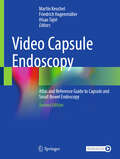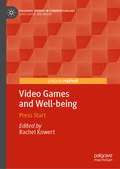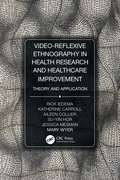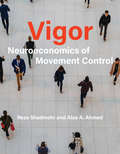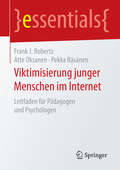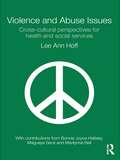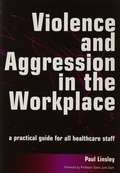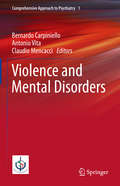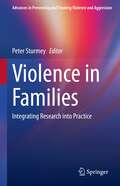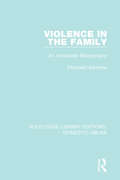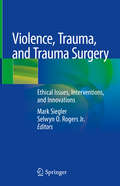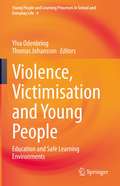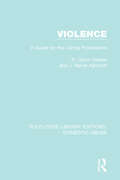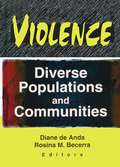- Table View
- List View
Video Capsule Endoscopy: Atlas and Reference Guide to Capsule and Small Bowel Endoscopy
by Martin Keuchel Friedrich Hagenmüller Hisao TajiriThis fully revised and expanded second edition provides a comprehensive and most up-to-date overview of the technique and performance of video capsule endoscopy. History, technique, performance, reading, indications, contraindications, outcomes, complications, and alternative methods are described systematically by a large international panel of experts. In addition, the full range of small bowel diseases, from the common to the rare, are described and illustrated using a unique and exhaustive collection of capsule endoscopy images that are accompanied by corresponding images of enteroscopy, surgery, radiology and histology whenever possible. This second edition includes a wealth of new images and covers new topics such as non-imaging capsules, and panintestinal capsule endoscopy. Moreover, new clinical guidelines and quality parameters describe the current standard of care in capsule endoscopy. The newest technology of colon capsule endoscopy is covered as well as magnetic capsule endoscopy of the stomach. Exciting potential future developments in hardware and artificial intelligence are also considered. This superb atlas and detailed guide will be indispensable for all who use the technique or are considering establishing a video capsule endoscopy service.
Video Games and Well-being: Press Start (Palgrave Studies in Cyberpsychology)
by Rachel KowertThis book examines how video game mechanics and narratives can teach players skills associated with increased psychological well-being. It integrates research from psychology, education, ludology, media studies, and communication science to demonstrate how game play can teach skills that have long been associated with increased happiness and prolonged life satisfaction, including flexible thinking, openness to experience, self-care, a growth mindset, solution-focused thinking, mindfulness, persistence, self-discovery and resilience. The chapters in this volume are written by leading voices in the field of game studies, including researchers from academia, the video gaming industry, and mental health practitioners paving the way in the field of “geek therapy.” This book will advance our understanding of the potential of video games to increase our psychological well-being by helping to mitigate depression, anxiety, and stress and foster persistence, self-care, and resilience.
Video-Atlas of VATS Pulmonary Sublobar Resections
by Carlos Galvez Sergio Bolufer Santiago Figueroa Andrés ObesoThe Video-Atlas of Pulmonary Sublobar Resections aims to be a reference multimedia book for Thoracic Surgeons. Mainly focused on operative technical aspects, each individual segmentectomy and many combinations are described. Each chapter opens with anatomical 3D reconstructions of the segment and its bronchoscopic anatomy. Then, the main steps for performing the procedure, that are illustrated in high-definition (HD) video-clips and figures, are described. Expert authors highlight specifical tips & tricks for succesfully performing the resection, and include anatomical variations that also illustrate with HD video-clips.This illustrated guide provides thoracic surgeons with an incredibly useful tool for learning and improving their technique in sublobar resections.Videos and more: Download the free Springer Multimedia App - Scan dedicated images in this book to stream videos or access and download supplementary material.
Video-Reflexive Ethnography in Health Research and Healthcare Improvement: Theory and Application
by Jessica Mesman Rick Iedema Mary Wyer Katherine Carroll Aileen Collier Su-Yin HorThis innovative, practical guide introduces researchers to the use of the video reflexive ethnography in health and health services research. This methodology has enjoyed increasing popularity among researchers internationally and has been inspired by developments across a range of disciplines: ethnography, visual and applied anthropology, medical sociology, health services research, medical and nursing education, adult education, community development, and qualitative research ethics.
Videotherapie und Videosupervision: Praxishandbuch für Psychotherapie und Beratung online (Psychotherapie: Praxis)
by Susanna Hartmann-StraussDieses Manual für Psychotherapeuten und Supervisoren zeigt, wie Sprechstunde und Supervision per Video gelingen – einem Medium, dem in der Beratungsbeziehung oft das Etikett der zweiten Wahl anhaftet. Richtig genutzt bietet die Videotherapie jedoch Möglichkeiten, die über die Face-to-Face-Interaktion hinausgehen. Exposition, Rollenspiel und Entspannung – das alles funktioniert online. Die Videobehandlung erleichtert die Umsetzung von Interventionen, stärkt die professionelle Interaktion und fördert so therapeutische Effekte. Hierfür muss eine hohe Vertrautheit mit dem Medium und der Kommunikation innerhalb des Mediums vorhanden sein sowie eine Sensibilität für die Grenzen des Einsatzes. Neben rechtlichen und technischen Grundlagen vermittelt das Praxishandbuch daher Gesprächsstrategien und Adaptionen der wesentlichen therapeutischen und supervisorischen Vorgehensweisen. Aus dem Inhalt: Technische und rechtliche Grundlagen – Vorbehalte – Sitzungsorganisation – Struktur und Ablauf – Interventionen – Dos and Don'ts. Geschrieben für Psychotherapeuten und Supervisoren und zudem alle Berater, die Video nutzen, um mit ihren Klienten zu kommunizieren. Über die Autorin: Susanna Hartmann-Strauss ist Diplompsychologin, Psychologische Psychotherapeutin und Supervisorin. Sie arbeitet kassenzugelassen in eigener Praxis, ist seit mehr als 15 Jahren in der Weiterbildung tätig und begeisterte Onlinetherapeutin.
Viele Wege führen zum Glück: Experten stellen vor
by Andrea Fischer Christin PrizeliusVerschiedene Wege führen zum Glück – finden Sie Ihren!Dieses Buch richtet sich an alle Menschen, die sich mit dem Thema Glück für sich und andere beschäftigen, und zeigt, dass das Glück oft näher und greifbarer ist als gedacht. Für jeden bedeutet Glück etwas anderes und jeder Mensch darf dabei selbst herausfinden, was ihn glücklich macht. Wissenschaftlich fundiert und praxisnah bieten die Autoren vielseitige Inspirationen zum Thema. Sowohl aktuelle Forschungsfelder als auch individuelle Projekte werden verständlich und konkret dargestellt. Dabei wird der Leser eingeladen zu reflektieren und eigene Impulse zu setzen. Ziel ist mehr Lebensfreude, eine ganzheitliche positive Ausrichtung und Einstellung, sowohl für den Einzelnen als auch die Gesellschaft und damit eine bessere Gesundheit und mehr Wohlbefinden. Entdecken Sie Ihren Weg zum Glück und gestalten Sie ihn selbst aktiv mit!
Vigor: Neuroeconomics of Movement Control
by Reza Shadmehr Alaa A. AhmedAn examination of the link between the vigor with which we move and the value that the brain assigns to the goal of the movement.Why do we reflexively run toward people we love, but only walk toward others? In Vigor, Reza Shadmehr and Alaa Ahmed examine the link between how the brain assigns value to things and how it controls our movements. They find that brain regions thought to be principally involved in decision making also affect movement vigor--and that brain regions thought to be principally responsible for movement also bias patterns of decision making.
Viktimisierung junger Menschen im Internet: Leitfaden für Pädagogen und Psychologen (essentials)
by Frank J. Robertz Atte Oksanen Pekka RäsänenDieses essential gibt einen Überblick über potenzielle Gefahren der Internetnutzung für junge Menschen. Die Autoren befassen sich dabei insbesondere mit Risiken, die aus hassbasiertem Online-Material und möglicherweise schädigenden Inhalten hervorgehen. Ihre Ausführungen werden durch eine Darstellung aktueller Forschungsergebnisse im Ländervergleich ergänzt. Abschließende Empfehlungen zur Verbesserung des Schutzes von Kindern und Jugendlichen im Cyberspace helfen dabei, unserer Verantwortung für die junge Generation besser gerecht zu werden.
Village Midwife, Blushing Bride: A Wonderfully Charming Medical Romance (Medical Romances #23)
by Gill SandersonAnother captivating medical romance from best-selling author Gill Sanderson! Perfect for fans of Mia Faye, Laura Scott, Helen Scott Taylor, Grey's Anatomy and ER.Readers ADORE Gill's gripping medical romances!'I loved every part of this book Gill Sanderson is a great storyteller' 5* reader review 'What a truly wonderful writer... This book is highly recommended!' 5* reader review'A truly gifted writer with an enormous amount of talent and sensitivity' 5* author reviewMidwife Zoe Hilton was starting a new life away from the city. A small Derbyshire town, old friends in the practice she was joining, perhaps best of all a cottage that suited her perfectly. Here, she and her son Jamie could be happy. The owner of the cottage was Dr Connor Maitland, who lived in the large house next door. He was a partner in the practice.Because of an illness Dr Maitland has been forced to give up his work as a surgeon and become a GP. He is an unusual neighbour, Zoe can't work out whether he is unfriendly or shy. But he does seem to get on well with Jamie. In time Connor and Zoe get close. But both have ghosts to lay before they can move on.Don't miss Gill Sanderson's enthralling medical romances, including the A Lakeland Practice and the Good, Bad and Ugly series.
Vintage Sacks
by Oliver SacksOliver Sacks' empathetic understanding and compelling storytelling ability have turned his accounts of his patients and his own life into literature, as evidenced in "Uncle Tungsten," "Stinks and Bangs," and "Cannery Row" from Uncle Tungsten; the Foreword and "Rose R." from Awakenings; "A Deaf World" from Seeing Voices; and excerpts from "Island Hopping" and "Pingelap" from The Island of the Colorblind.
Vintage Sacks
by Oliver SacksVintage Readers are a perfect introduction to some of the great modern writers presented in attractive, accessible paperback editions."It is Dr. Sacks's gift that he has found a way to enlarge our experience and understanding of what the human is." --The Wall Street JournalDubbed "the poet laureate of medicine" by The New York Times, Oliver Sacks is a practicing neurologist and a mesmerizing storyteller. His empathetic accounts of his patients's lives--and wrily observed narratives of his own--convey both the extreme borderlands of human experience and the miracles of ordinary seeing, speaking, hearing, thinking, and feeling. Vintage Sacks includes the introduction and case study "Rose R." from Awakenings (the book that inspired the Oscar-nominated movie), as well as "A Deaf World" from Seeing Voices; "The Visions of Hildegard" from Migraine; excerpts from "Island Hopping" and "Pingelap" from The Island of the Colorblind; "A Surgeon's Life" from An Anthropologist on Mars; and two chapters from Sacks's acclaimed memoir Uncle Tungsten.From the Trade Paperback edition.
Vintage Sacks
by Oliver SacksVintage Readers are a perfect introduction to some of the great modern writers presented in attractive, accessible paperback editions."It is Dr. Sacks's gift that he has found a way to enlarge our experience and understanding of what the human is." --The Wall Street JournalDubbed "the poet laureate of medicine" by The New York Times, Oliver Sacks is a practicing neurologist and a mesmerizing storyteller. His empathetic accounts of his patients's lives--and wrily observed narratives of his own--convey both the extreme borderlands of human experience and the miracles of ordinary seeing, speaking, hearing, thinking, and feeling. Vintage Sacks includes the introduction and case study "Rose R." from Awakenings (the book that inspired the Oscar-nominated movie), as well as "A Deaf World" from Seeing Voices; "The Visions of Hildegard" from Migraine; excerpts from "Island Hopping" and "Pingelap" from The Island of the Colorblind; "A Surgeon's Life" from An Anthropologist on Mars; and two chapters from Sacks's acclaimed memoir Uncle Tungsten.From the Trade Paperback edition.
Violence and Abuse Issues: Cross-Cultural Perspectives for Health and Social Services
by Lee Ann HoffAfter centuries of being considered a private matter in most societies, violence and its profound effect on the physical health, mental health, and social well-being of victims and their families, as well as on the assailants themselves, has started to take centre stage as a public issue of worldwide concern. Health and social service providers are in pivotal positions to provide preventive and restorative services to those affected by violent and abusive behaviour. This comprehensive textbook presents theoretical background and practical strategies for doing so, providing a solid knowledge base for good practice in this area. It emphasizes the interdisciplinary aspects of violence and victim/survivor care and addresses violence over the lifespan, covering: child sexual and physical abuse sexual assault of adults battering and emotional abuse of intimate partners elder abuse perpetrators of violence and abuse violence in learning and work environments vicarious trauma and self-care interconnections between various forms of violence, including socially approved violence in the media and in war. This text is an essential resource for qualified practitioners wanting to learn more about this area and for students starting out in health and social care. Each chapter includes case studies and thinking points, and suggestions for application in practice settings. A companion website provides materials for students and educators, enabling the inclusion of violence issues in an already busy curriculum. Lee Ann Hoff is a nurse-anthropologist and crisis specialist. She has published widely and is the author of the award-winning textbook People in Crisis. She has extensive experience as an educator, consultant, clinician, and crisis service manager.
Violence and Aggression in the Workplace: A Practical Guide for All Healthcare Staff
by Paul LinsleyThis is a practical guide that will support primary care members through the process of change towards PCT status and assist those with PCT status. The contributors present real solutions to the many unique issues faced in this new stage of NHS development. Endorsed by the National Association of Primary Care it is an authoritative guide for the present and for future development. All members of the new primary care organisations and those supporting them will find this handbook to be an enlightening and indispensable guide.
Violence and Aggression: Integrating Theory, Research, and Practice (Advances in Preventing and Treating Violence and Aggression)
by Peter SturmeyThis book provides a concise-yet-comprehensive overview of the broad-ranging topics in the field of violence and aggression. It uses a functional approach that acknowledges the evolutionary, cultural, and operant nature of violence and aggression. The book defines the nature of different forms of violence and aggression; examines epidemiology and risk factors; describes biological, cultural and individual causes; and discusses individual and societal prevention and treatment. Key areas of coverage include: Epidemiology of violence and aggression.Biological and social causes of violence and aggression.Cultural interventions, psychotherapies, and individual biological interventions.The effects of violence and aggression in special populations. Violence and Aggression: Integrating Theory, Research, and Practice is a must-have resource for researchers, academics, and upper-level undergraduate and graduate students in forensic psychology, public health, criminology/criminal justice, developmental psychology, psychotherapy/counseling, psychiatry, social work, educational policy and politics, health psychology, nursing, and behavioral therapy/rehabilitation.
Violence and Mental Disorders (Comprehensive Approach to Psychiatry #1)
by Antonio Vita Bernardo Carpiniello Claudio MencacciThis book explores the issue of violence in detail, taking into account the role of contextual factors, as well as the epidemiology, risk factors and clinical aspects of violence related to the main mental disorders. It also offers practical information on its management – from prevention to treatment.Covering all aspects of the problem of violence in mental disorders, the book is divided into four parts: general aspects; risk factors, phenomenology and characteristics of violence in mental disorders; contexts of violence; and prevention and management of violence in mental health. It also discusses violence in the various settings of mental health system, an aspect that has not previously been fully addressed. The volume is intended for all those who are interested in mental health, including scholars, professionals, and students.
Violence and Mental Health
by Jutta Lindert Itzhak LevavViolence is one of the most important challenges, not only for public health systems, but also for public mental health. Violence can have immediate as well as long-term and even transgenerational effects on the mental health of its victims. This book provides a comprehensive and wide-ranging assessment of the mental health legacy left by violence. It addresses the issues as they affect states, communities and families, in other words at macro-, meso- and microlevels, beginning by describing the impact of violence on neurobiology and mental health, as well as the spectrum of syndromes and disorders associated with different forms of violence. The work moves on to tackle violence at the international--and intranational--level before zeroing in on the nature of violence in communities such as villages or city districts. It also examines the results of violence in the family. Each type of violence has distinct effects on mental health and in each chapter specific groups are explored in depth to demonstrate the heterogeneity of violence as well as the diversity of its outcomes in the realm of public mental health. Finally, the book addresses the notion of 'undoing violence' by detailing case studies of effective interventions and prevention occurring in countries, communities and families. These cases give us pause to reflect on the nature of resilience and dignity in the context of violence and mental health. All the chapters have been written by leading authors in the field and provide a state-of-the-art perspective. The authors, from different fields of expertise, facilitate interdisciplinary and international insights into the impact of violence on mental health.
Violence in Families: Integrating Research into Practice (Advances in Preventing and Treating Violence and Aggression)
by Peter SturmeyThis book examines the nature, prevention, and treatment of violence within families. It reviews the definition of contemporary families, emphasizing various structures, including nuclear families, reconstituted families, gay and lesbian families, and recent immigrant families. In addition, the volume describes the nature of and risk factors for family violence from the perspectives of both victims (e.g., infants, children, seniors) and perpetrators (e.g., adolescent family members, women). It identifies the implications and explores strategies for prevention, treatment, and services. In addition, the volume directly addresses practice and evidence-based interventions for individual perpetrators, family interventions, interventions for victims and systemwide interventions (e.g., those involving the courts, police, and national policy). Chapters review the best available quality evidence from randomized controlled trials, systematic reviews, meta-analyses, research syntheses, and evidence-based recommendations from expert panels and government agencies. Case studies illustrate the application of evidence-based practice to violence within the family to demonstrate the effectiveness of the intervention. Topics featured in this book include:Definition and conceptualization of family.Definition and measurement of as well as risk factors for family violence.Family violence in various traditional and nontraditional families.Prevention strategies as well as Individual and family treatments for perpetrators and victims of family violence.Social policy and legal interventions for family violence. Violence in Families is a must-have resource for researchers, professors, and graduate students as well as clinicians, therapists, and other professionals in developmental psychology, family studies, forensic psychology, criminology/criminal justice, public health, psychotherapy/counseling, psychiatry, social work, educational policy and politics, health psychology, nursing, and behavioral therapy/rehabilitation.
Violence in Psychiatry
by Stephen M. Stahl Warburton, Katherine D. and Stahl, Stephen M. Katherine D. WarburtonThe association between violence and mental illness is well studied, yet remains highly controversial. Currently, there does appear to be a trend of increasing violence in hospital settings, including both civilly and forensically committed populations. In fact, physical aggression is the primary reason for admission to many hospitals. Given that violence is now often both a reason for admission and a barrier to discharge, there is a pressing need for violence to be re-conceptualized as a primary medical condition, not as the by-product of one. Furthermore, treatment settings need to be enhanced to address the new types of violence exhibited in inpatient environments and this modification needs to be geared toward balancing safety with treatment. This book focuses on violence from assessment, through underlying neurobiology, to treatment and other recommendations for practice. This will be of interest to forensic psychiatrists, general adult psychiatrists, psychiatric residents, psychologists, psychiatric social workers and rehabilitation therapists.
Violence in Pursuit of Health: Living with HIV in the American Prison System (Palgrave Studies in Prisons and Penology)
by Landon KuesterThis book offers a unique examination of how violence is situationally induced and reproduced for those inmates living with HIV in a US State prison system. Imprisonment is the only space where Americans have a constitutional right to healthcare but findings from this research suggest that accessing this care and associated welfare benefits requires some degree of violence. This book documents how HIV-positive inmates went about achieving agency through harm to their bodies and social standing to improve their health and wellbeing, in prison and upon re-entry to the community. It focusses on ethnographic research which was carried out in seven penal facilities in New England and comprises of accounts from inmates, prison staff, healthcare providers, ex-offenders, and community social workers. This book speaks to academics interested in prisons, violence, health, and ethnographic research, and to policy makers.
Violence in the Family: An annotated bibliography (Routledge Library Editions: Domestic Abuse #4)
by Elizabeth KemmerIn the early 1970s, the problem of abuse within the family unit began to surface on a large scale and 1975 was a particularly significant year for the recognition of interfamilial violence. This recognition provided the impetus for more concern and investigation of the issue and significant literature on family violence began to emerge during this period. First published in 1984, this bibliography contains information published in English on domestic violence and abuse from 1960-1982. It is arranged alphabetically by author, or by the first significant word in the title if no author is given. A concise subject index and an author index follow the bibliography itself. This book will be a valuable resource to those studying social work, health care, mental health, sociology, women’s studies and law.
Violence, Trauma, and Trauma Surgery: Ethical Issues, Interventions, and Innovations
by Mark Siegler Selwyn O. RogersThis unique and innovative title offers a comprehensive exploration of the intersection of ethics, violence, trauma, and trauma surgery. Underscoring that the causes of violence include a wide range of socioeconomic factors, including poverty and the lack of economic opportunity, and that violence often occurs in impoverished and underserved communities, various authors from a wide range of disciplines outline how intentional violence toward another person is multidimensional and complex. Many of the authors use Chicago as a framework for their chapter discussion, but there are similarities in many urban settings throughout the United States and abroad. Part I of the book, Ethical Issues Related to Violence, includes seven chapters that examine ethical issues related to violence. Each of these chapters discusses a different but intersecting aspect of how violence challenges ethical standards in medicine and health. Part II, Ethical Issues Related to Trauma and Trauma Surgery, offers eight chapters that address various aspects of ethical issues related to trauma and trauma surgery. Part III, Additional Concerns Relating to Violence and Trauma, describe a series of issues relating to violence and trauma, including surgical procedures, psychological distress, and geographic disparities in access to trauma care. Developed by nationally renowned thought leaders in the field, Violence, Trauma, and Trauma Surgery is a major and novel contribution to the clinical literature and will be of great interest to all physicians, clinicians, researchers, social scientists, students, policymakers, hospital administrators and community leaders concerned with understanding and improving outcomes relating to violence, trauma, and trauma surgery.
Violence, Victimisation and Young People: Education and Safe Learning Environments (Young People and Learning Processes in School and Everyday Life #4)
by Thomas Johansson Ylva OdenbringThis edited collection focuses on different aspects of everyday violence, harassment and threats in schools. It presents a number of in-depth studies of everyday life in schools and uses examples and case studies from different countries to fuel a discussion on national differences and similarities. The book discusses a broad range of concepts, findings and issues, under the umbrella of three main themes: 1) Power relations, homosociality and violence; 2) Sexualized violence and schooling; and 3) Everyday racism, segregation and schooling. Specific topics include sexuality policing, bullying, sexting, homophobia, and online rape culture. The school is young people’s central workplace, and therefore of great importance to students’ general feeling of wellbeing, safety and security. However, there is no place where youth are at greater risk of being exposed to harassment and violations than at school and on their way to and from school. Threats are a relatively common experience among school students, but some aspects of these mundane and frequent harassments and violations are not taken seriously and are, therefore, not reported. Harassment and violations often have negative effects on youth and children, and increase their risks of such adverse outcomes as school dropout, drug use, and criminal behaviour. Contemporary research has shown that gender is of great importance to how students handle and report, or do not report, various violent situations. Studies have also revealed how the notions of masculinity and of being a victim can be conflicting identities and affect how students handle situations of threat, violence and harassment. The importance of gender is also particularly evident with regard to sexual harassment. Female students generally report greater exposure to sexual harassment than male students do.
Violence: A Guide for the Caring Professions (Routledge Library Editions: Domestic Abuse)
by R. Glynn Owens J. Barrie AshcroftFirst published in 1985, this book is designed to help professionals in caring professions understand and deal with the problem of violent behaviour. It explains how theoretical ideas may be translated into practical strategies for the reduction or elimination of violence. It also highlights the issues and problems involved in the evaluation of intervention strategies aimed at dealing with aggressive behaviour. Although the book is based firmly on scientific research, the emphasis is on the practical problem of dealing with violence. As such it will be of interest to those studying social care and social work, but also those whose professional duties bring them face to face with violent behaviour.
Violence: Diverse Populations and Communities
by Diane Deanda Rosina M BecerraUnderstand violence within its cultural context!To reduce violence, we need to understand what it is, where it comes from, and what it means in cultural context. Violence: Diverse Populations and Communities provides new empirical research and theoretical models to help you understand the impact of violence on various ethnic and cultural groups. From the effects of abuse on Latino children to aged Korean-American women's perceptions of elder mistreatment, this comprehensive volume covers all ages, many ethnic groups, and multiple types of violence.Violence: Diverse Populations and Communities looks at such neglected populations as Mexican, Korean, Vietnamese, and Cambodian immigrants as well as Black, Caucasian, and Latino cultures. The forms of violence studied range from the devastation of war to keeping elders isolated for long periods of time and culturally specific forms of abuse. This comprehensive volume also includes a thorough literature review, stressing the need for more research, especially into the needs and experiences of neglected populations, and suggesting fruitful areas for further inquiry. Violence: Diverse Populations and Communities asks and answers complex questions, including: Is war or street violence more traumatic for adolescent refugees from the Khmer Rouge? What social support benefits do street gangs offer their members? How do cultural expectations of male and female roles affect dating violence? What culturally sensitive interventions best address the needs of a Latina rape survivor? How do women of various Asian cultures respond to spousal battering? How can practitioners working with elder abuse victims define their roles, objectives, and interventions to accommodate cultural differences?The groundbreaking research in Violence: Diverse Populations and Communities provides an illuminating exploration into the cultural meaning of violence. By questioning standard assumptions and discovering what violence means to those who suffer from it and perpetrate it, practitioners can better serve multicultural client populations. This book will change the way you see violence by helping you understand its manifestations within various cultural contexts.
